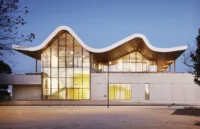In a world that’s increasingly urbanized, the need to reconnect with nature has never been more critical. As architects and designers, we have the unique opportunity to blend the built environment with the natural world, creating spaces that are both functional and harmonious. Incorporating nature into architecture isn’t just about aesthetics; it improves mental well-being, reduces stress, and promotes sustainability.
From green roofs to living walls, there are numerous techniques we can use to bring nature into our designs. These methods not only enhance the visual appeal of our projects but also contribute to a healthier and more sustainable future. Let’s explore some of the most effective ways to integrate nature into architectural design, making our living and working spaces more enjoyable and eco-friendly.

Understanding Nature-Inspired Architecture
Nature-inspired architecture aims to seamlessly blend built environments with natural landscapes. This approach prioritizes harmony between structures and surroundings to enhance the well-being of occupants and minimize environmental impact.
Biophilic Design Principles
Biophilic design principles focus on incorporating natural elements into architectural spaces. These principles include using natural light, integrating water features, and incorporating plant life within the design. Examples are large windows for daylight, interior gardens, or atriums.
Use of Sustainable Materials
Using sustainable materials is crucial in nature-inspired architecture. Common materials include reclaimed wood, recycled metal, and natural stone. These materials reduce the carbon footprint of a building while giving it a timeless, organic aesthetic.
Green Infrastructure
Green infrastructure involves integrating living elements into the built environment. Techniques such as green roofs and living walls are popular. Green roofs provide insulation and help manage rainwater, whereas living walls improve air quality and biodiversity.
Natural Ventilation Systems
Natural ventilation systems utilize the wind and thermal buoyancy to circulate air throughout a building. These systems reduce dependence on mechanical cooling and improve indoor air quality. Cross-ventilation and solar chimneys are typical examples.
Landscape Integration
Landscape integration aims to harmonize buildings with their natural surroundings. Techniques include using local flora for landscaping, creating natural water features, and preserving existing ecosystems. This approach strengthens the connection between occupants and the environment.
Renewable Energy Solutions
Incorporating renewable energy is vital in nature-inspired designs. Solar panels, wind turbines, and geothermal systems can be integrated into the architecture. These solutions reduce reliance on non-renewable energy and lower operating costs.
Water Management Systems
Effective water management systems ensure sustainability. Techniques involve rainwater harvesting, greywater recycling, and the use of permeable surfaces. These methods help conserve water and reduce runoff.
Well-being and Productivity Enhancements
Spaces designed with natural elements enhance well-being and productivity. Benefits include reduced stress, improved mood, and increased focus. Examples include office spaces with indoor plants and natural light.
Integrating nature into architecture creates structures that foster a deeper connection with the environment. From biophilic design principles to renewable energy solutions, nature-inspired techniques support holistic well-being and environmental sustainability in architectural projects.

Biophilic Design Principles
Biophilic design principles focus on integrating natural elements into architectural spaces to connect occupants with the natural environment. These principles enhance well-being, reduce stress, and promote sustainability.
Creating Natural Light
Maximizing natural light involves designing with large windows, skylights, and light wells. Strategic placement of windows, such as south-facing windows in the northern hemisphere, ensures ample sunlight. Natural light reduces the need for artificial lighting, lowering energy consumption.
Use of Natural Materials
Using natural materials like wood, stone, and bamboo creates a tactile connection to nature. Reclaimed wood and recycled metal offer sustainability while maintaining aesthetics. In addition to reducing carbon footprints, these materials enhance the organic atmosphere of spaces.
Green Roofs and Walls
Green roofs and walls serve as multifunctional solutions that blend nature with urban architecture. They offer numerous benefits that enhance the sustainability and aesthetic appeal of buildings.
Benefits of Green Roofs
Green roofs, also known as living roofs, provide a host of environmental, economic, and social advantages. First, they significantly reduce the urban heat island effect by cooling the surrounding air. According to the National Research Council of Canada, green roofs can lower rooftop temperatures by up to 40°F. Additionally, they enhance stormwater management by absorbing rainfall, reducing runoff, and mitigating the risk of flooding. A study by the University of Melbourne found that green roofs can retain up to 75% of rainwater, easing the burden on drainage systems.
In economic terms, green roofs extend the lifespan of roofing materials by protecting them from ultraviolet radiation and extreme temperature fluctuations. The University of Michigan reported that a green roof can double or triple the service life of a traditional roof. Also, they help insulate buildings, leading to energy savings by reducing the need for heating in winter and cooling in summer. Lastly, green roofs provide urban biodiversity habitats, fostering ecosystems for birds, insects, and plants in otherwise concrete-dominated environments.
Advantages of Green Walls
Green walls, or living walls, offer several benefits similar to green roofs, with added vertical appeal. They improve air quality by filtering pollutants and carbon dioxide while releasing oxygen. A NAHRO study indicated that a green wall can remove up to 2.3 kg of CO2 annually per square meter of vegetation. Natural insulation provided by green walls also enhances thermal regulation of buildings, reducing energy costs for heating and cooling.
From an aesthetic standpoint, green walls transform bland concrete exteriors into vibrant, living artworks that promote well-being. Research by the University of Exeter revealed that exposure to green walls can reduce psychological stress and improve mental health. They also play a role in sound insulation, significantly reducing noise pollution in urban areas. Lastly, green walls offer space-efficient greening in densely built environments, making them an ideal solution for urban biodiversity in limited spaces.

Integrating Water Features
Incorporating water features into architectural design bridges built environments and natural elements. Water elements enhance tranquility, visual appeal, and environmental balance.
Indoor Waterfalls
Indoor waterfalls create soothing ambiance in enclosed spaces. They enhance air quality and provide natural humidity control. For instance, foyer areas in commercial buildings benefit from vertical waterfalls, which also serve as art pieces. These waterfalls can be incorporated into living walls, further blending water and greenery. Using recycled water for these features conserves resources.
Reflecting Pools
Reflecting pools offer both aesthetic and environmental benefits. They create serene atmospheres and reduce heat island effects in urban areas. Placing reflecting pools in courtyards boosts natural light, as water surfaces effectively reflect sunlight. Sustainable designs often incorporate rainwater harvesting systems to refill these pools, minimizing water waste. Examples of this integration can be seen in contemporary public plazas. Reflecting pools complement surrounding landscaping, creating cohesive, nature-inspired spaces.
Utilizing Outdoor Spaces
Outdoor spaces are essential for integrating nature into architectural designs. They provide opportunities for relaxation, socialization, and a deeper connection with the environment.
Courtyards and Gardens
Courtyards and gardens enhance the architectural design by bringing natural elements directly into living spaces. Courtyards, often situated at the center of buildings, create private, tranquil areas shielded from street noise. They promote natural light penetration and ventilation, reducing reliance on artificial systems. Traditional gardens, positioned around buildings or within larger complexes, offer walking paths, seating areas, and diverse plant species to enhance biodiversity. Japanese Zen gardens, for instance, use rocks, sand, and minimalist plantings to create peaceful retreats that encourage mindfulness and stress reduction.
Rooftop Gardens
Rooftop gardens maximize the otherwise underutilized spaces atop buildings. They can reduce energy costs by providing natural insulation and lowering the heat island effect. Green roofs, featuring grasses, flowers, and edible plants, improve air quality and offer habitats for urban wildlife. Extensive green roofs, with a shallow soil depth, are lightweight and require minimal maintenance, making them ideal for retrofitting older buildings. Intensive green roofs, with deeper soil, support a wider variety of plants, including small trees and shrubs, and often incorporate additional features like seating areas or water elements. Rooftop gardens also enhance the aesthetic appeal of buildings, transforming stark rooftops into vibrant, usable spaces.

Sustainable Building Practices
Sustainable building practices are essential for reducing environmental impact and promoting long-term viability.
Energy Efficiency
Incorporating energy-efficient systems reduces energy consumption and greenhouse gas emissions. We should prioritize designing buildings with proper insulation, high-performance windows, and energy-efficient HVAC systems. For example, buildings with double-glazed windows maintain interior temperatures, reducing heating and cooling needs. Smart lighting systems, which use sensors and timers, minimize electricity usage and enhance energy conservation. Integrating renewable energy sources like solar panels and wind turbines further cuts reliance on fossil fuels.
Waste Reduction
Effective waste reduction strategies during construction and operation lower environmental footprints. We can use materials from sustainable sources, such as reclaimed wood and recycled metal, to minimize resource depletion. Modular construction techniques, which involve prefabricating components off-site, reduce material wastage and promote efficient assembly. Implementing comprehensive recycling programs on construction sites ensures that materials like concrete and metals are reused or recycled rather than discarded. Designing for adaptability and flexibility allows buildings to be repurposed, reducing the need for demolition and new construction.
Conclusion
Integrating nature into architecture is fundamental for creating spaces that align with our environment’s well-being and sustainability. Techniques like green roofs and living walls not only enhance aesthetics but also contribute to reducing stress and improving mental health. Incorporating natural elements, such as light and water features, alongside sustainable materials, helps reduce carbon footprints while providing functional and appealing spaces.
Using biophilic design principles, we can ensure that architectural spaces harmonize with natural landscapes, thereby benefiting occupants and the environment. Green infrastructure, which includes living roofs and natural ventilation systems, enhances air quality and promotes effective rainwater management. Additionally introducing renewable energy solutions and effective water management systems ensures resource conservation and environmental stewardship.
Maximizing natural light and using natural materials infuses a tactile connection to nature within architectural designs. This practice offers aesthetic and sustainable advantages. Green roofs and walls transform urban architecture, mitigating the urban heat island effect, managing stormwater, and promoting urban biodiversity. Water features and outdoor spaces further bridge the gap between built environments and nature while providing relaxation and socialization avenues.
Sustainable building practices, such as energy-efficient systems and waste reduction strategies, are crucial for decreasing environmental impact and ensuring long-term viability. By emphasizing energy efficiency, using high-performance windows, and following modular construction techniques, we can foster a deeper connection with nature. This approach supports holistic well-being in architectural projects.
















Leave a comment